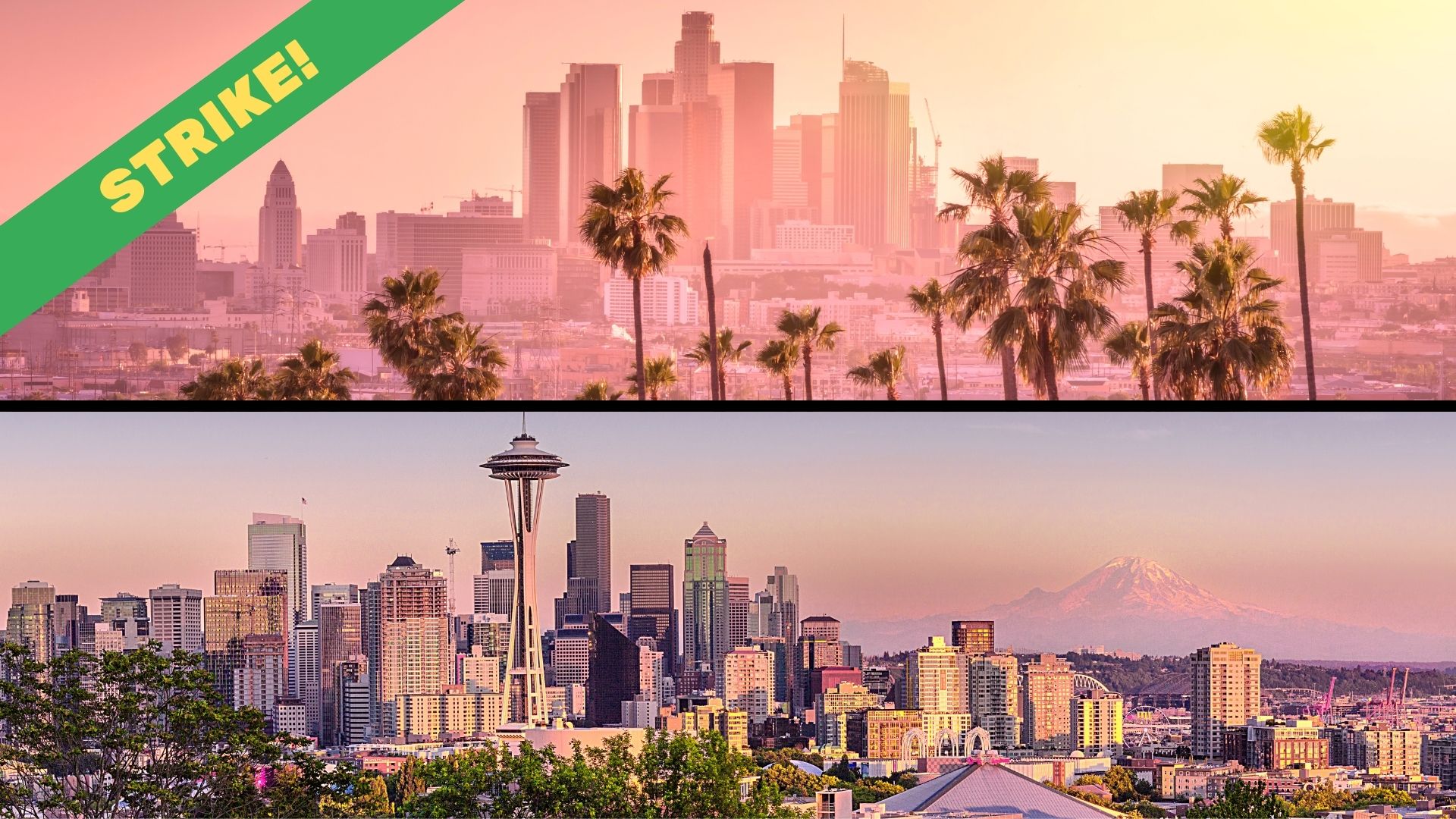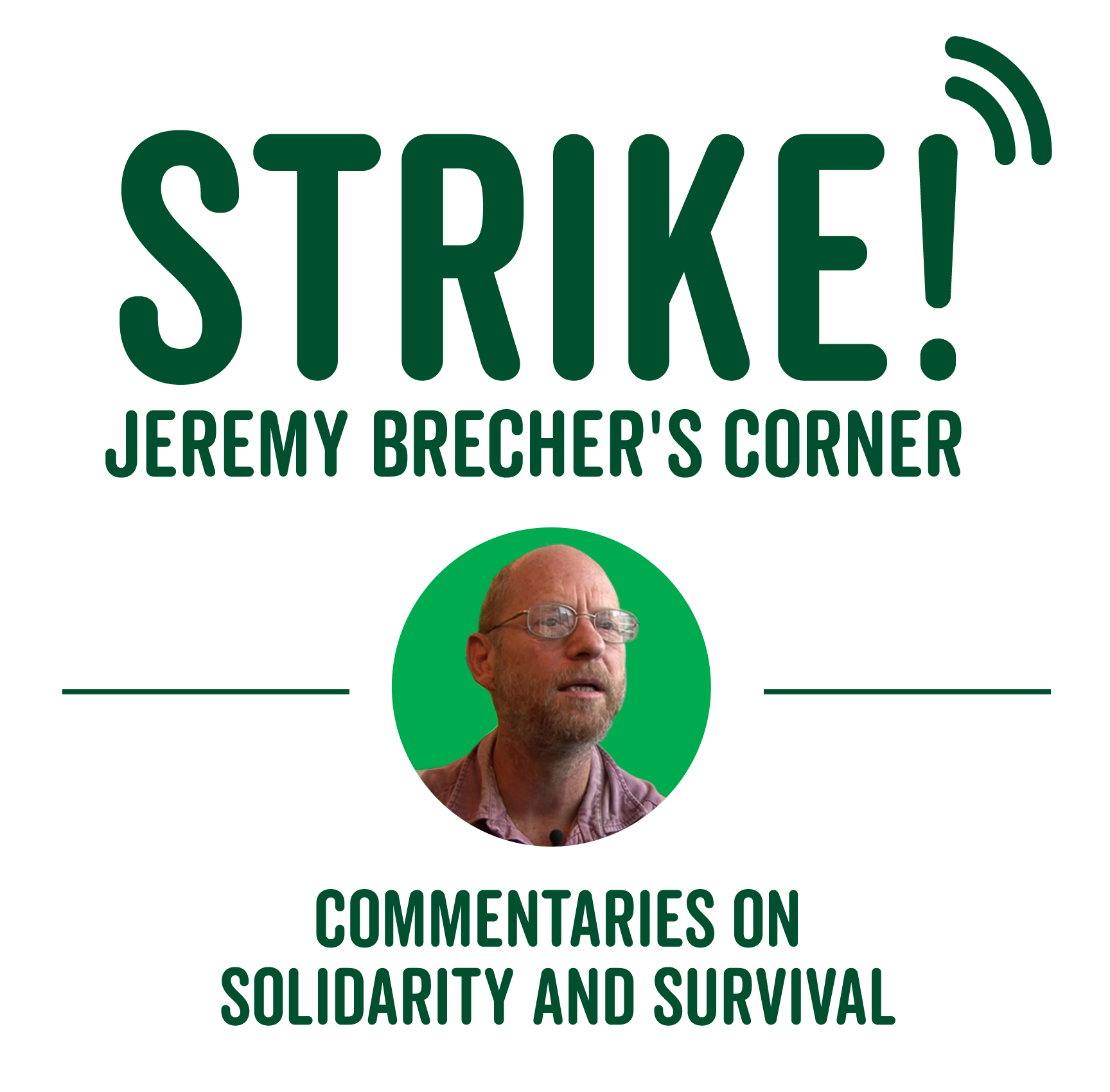While the Green New Deal has been largely blocked at the national level, it is thriving in communities, states, and cities. The previous Commentary, “The Green New Deal in the Cities – Part 1,” examined in depth Boston’s Green New Deal. This Commentary examines the Los Angeles and Seattle Green New Deals in the context of urban policy for climate justice.

As Part 1 of “The Green New Deal in the Cities” demonstrated, cities have enormous opportunities to establish Green New Deal-type programs – and an enormous need to do so. Worldwide, cities produce more than 70% of carbon emissions. US cities are marked by extremes of climate change vulnerability and extremes of wealth and poverty. And as shown by this series’ accounts of the Green New Deals in Boston, Los Angeles, and Seattle, cities have the capacity to realize much of the Green New Deal program of creating jobs and justice by protecting the climate.
Unfortunately, in many cities that capacity is not being used. Each year the research organization the American Council for an Energy Efficient Economy issues a “City Clean Energy Scorecard,” which has become a principal resource for tracking clean energy plans, policies, and progress in large US cities. Its 2021 report found that, of the 100 cities surveyed, 63 had adopted a community-wide greenhouse gas (GHG) goal; 38 had released enough data to assess progress toward their goals; and only 19 cities were on track to achieve their near-term GHS goals. Of the 177 new clean energy actions they reviewed, 38% related to adoption of a clean energy plan, partnership, goal, or governmental procedure. 34% were designed to improve energy efficiency of buildings. 28% promoted clean energy infrastructure. Less than 20% were equity-driven initiatives.
The Scorecard identified leading cities across five policy areas:
Community-wide initiatives: Seattle, San Jose, Denver, and Washington, D.C. have set GHG reduction goals; adopted strategies to mitigate the heat island effect; and pursued community engagement with historically marginalized groups.
Buildings: Denver, New York, and Seattle have established stringent building energy codes and requirements for energy performance in large existing buildings.
Transportation: San Francisco, Washington, D.C., and Boston have instituted location efficiency strategies, more efficient modes of transportation, transit and electric vehicle infrastructure investments, and have used transportation planning to reduce the isolation of historically marginalized communities.
Energy and water: Boston and San Jose have effective energy efficiency programs; programs to decarbonize the electric grid and reduce GHG emissions; and programs to simultaneously save water and energy.
Local government operations: Boston, Orlando, Portland, and San Francisco are substantially reducing local government GHG emissions through investments in energy-efficient municipal vehicle fleets, renewable energy systems, and complete municipal building retrofits.[1]
The “Scorecard” incorporated justice-oriented policies like requiring equity assessments for city policies and budgets, providing support for owners of affordable housing to achieve energy performance standards, funding subsidized access to public transportation for low-income communities, and creating utility-administered energy efficiency programs for low-income customers.[2]
The Green New Deals in Boston (described in the previous Commentary), Los Angeles, and Seattle provide a wholistic approach that addresses all of these policy areas as elements of a coordinated strategy of transformation.
The Los Angeles Green New Deal
L.A. Mayor Eric Garcetti Unveils City’s Green New Deal on Apr 29, 2019| Credit: KTLA 5
Los Angeles is the second largest city in the US with nearly four million residents. It has long been known as the “smog capital of America.”
In 2019 Los Angeles launched the Los Angeles Green New Deal. According to Mayor Eric Garcetti, the plan was based on four key principles:
- A commitment to the Paris Climate Agreement
- A responsibility to deliver environmental justice and equity through an inclusive economy guided by the communities themselves
- A duty to ensure that every Angeleno has the ability to join the green economy
- A resolve to demonstrate the art of the possible and lead the way.[3]
The plan calls for “five zeroes”: zero carbon electricity, zero carbon buildings, zero carbon transportation, zero waste, and zero wasted water.
Zero Carbon Grid: 100% carbon free by 2035
Zero Carbon Buildings: 100% net-zero carbon new buildings by 2030 and all buildings by 2050
Zero Carbon Transportation: 80% zero emission vehicles in the city by 2035 and 100% by 2050
Zero Waste: 95% landfill diversion rate by 2035 and 100% by 2050
Zero Wasted Water: 100 of wastewater recycled by 2035
The Los Angeles Green New Deal was one of the first city-based climate change action plans designed to meet the international Paris Agreement limits on global warming and achieve carbon neutrality by 2050. The plan laid out 445 initiatives estimated to create 300,000 green jobs by 2035 and 400,000 by 2050.[4]
At the end of May, 2022, the city released its third annual progress report on the LA Green New Deal.[5] It found that LA:
- Has met or is on track to meet 60% of its 97 Green New Deal goals for 2021
- generates 36% fewer emissions than in 1990
- Meets 43% of its energy needs with renewables like wind and solar
- Will generate 97% of energy with renewables by 2030
- Is ahead of schedule on EV charger installations, cool roof and cool pavement installations
- Is behind schedule on waste reduction and tree planting [6]
Early in 2022 the Los Angeles City Council established a moratorium on oil drilling; approved $110 million in the city budget to decarbonize nine city properties; and created a new Climate Emergency Mobilization Office.
In December, 2022 the Los Angeles city council passed and outgoing mayor Eric Garcetti signed a series of ordinances to phase out oil drilling, prohibit natural gas in new construction, and outlaw Styrofoam and single-use plastics.[7]
Buildings account for 43% of greenhouse gas emissions in Los Angeles. Another ordinance passed 12-0 by the City Council in December, 2022 requires new buildings to be all-electric. Starting in April 2023, new buildings are prohibited from having combustion equipment, gas piping, or fuel gas for purposes such as space and water heating, cooking, and drying clothes. Electricity must be the sole source of energy for all lighting, appliances, and equipment.
The ordinance was developed by the city in partnership with Leap LA, a coalition of community groups and environmental justice advocates, and received strong support from groups representing frontline communities. Gloria Medina, executive director of SCOPE LA, said community members in South Los Angeles made an effort to learn about decarbonization and the impacts of poor climate on their health. “It is about Black, Brown and Indigenous community members at the forefront,” Medina said of the ordinance. “This is their win.” Front-line communities have been raising concerns “for a long time,” according to Nancy Halpern Ibrahim, executive director of Esperanza Community Housing. Those concerns have “only recently” been “heeded by our systems and politicians,” she said in a statement. “We want to be clear that this was only possible because of the leadership of front-line communities.” Chelsea Kirk, policy analyst at Strategic Actions for a Just Economy, said, “We think this is a super important, logical first step that allows us to make progress in our net-zero carbon goals as outlined in the Green New Deal.” Retrofitting older buildings represents the logical next step, which will require protection for renters and an increase in production of renewable energy. According to Councilwoman Nithya Raman, “We are in a good position to be able to discuss those issues in detail, with the safeguards that we need to ensure that renters are not bearing the burden of retrofitting costs.”[8]
The Seattle Green New Deal
Earth Day in Seattle, Climate Justice Now!| Credit: 350 Seattle
Seattle represents a model of a municipal Green New Deal very different from Boston or Los Angeles. The initiative for the program came primarily from a coalition of activists, especially in poor communities, rather than from mayors and mayoral candidates. The program is paid for by a special tax on big business, voted by the city council. A Green New Deal Oversight Board with strong representation from climate-impacted communities makes recommendations for how to use the funds.
Syris Valentine, co-chair and youth representative on the Green New Deal Oversight Board, described its origin and development.[9] Shortly after the Sunrise Movement’s 2018 sit-in in House Speaker Nancy Pelosi’s office demanding a Green New Deal, members of the climate group 350 Seattle met over dinner to discuss the difficult task of pushing for national policy change from the local level. Someone asked, “What would it look like to have a Green New Deal for Seattle?” That kicked off a weeks-long discussion that included indigenous-led and frontline-focused organizations along with environmental NGOs.[10]
In June 2019 and following the wave of Sunrise Movement youth-led action for a national Green New Deal, 350 Seattle and Got Green, an environmental justice organization based in Seattle’s South End, teamed up to launch a campaign for a local Green New Deal.
The emerging coalition dubbed itself Seattle for a Green New Deal, “a people-powered movement demanding that the City of Seattle create its own Green New Deal to eliminate climate pollution by 2030.”[11]
Together, we mobilized over 10,000 people in the first 3 months of the campaign: we held community events; canvassed dozens of Seattle neighborhoods and organized a game-changing candidate forum (7 of 9 City Council seats were up that year!). And as all that organizing was underway, 350 Seattle and Got Green worked with a broad coalition of environmental justice groups and City Council champions to create Seattle’s Green New Deal resolution. This coalition included Got Green, Puget Sound Sage, Mazaska Talks, Chinese Information Services, Duwamish River Community Coalition, Transit Riders Union, Sierra Club and Emerald Cities Collaborative.[12]
The Green New Deal for Seattle was endorsed by over 200 organizations, including labor unions, advocates from low income and communities of color, tribal nations, faith leaders, health care providers, businesses, environmental advocates, and clean energy experts. 100 people delivered a letter to the Mayor demanding the city eliminate all emissions by 2030. In August a jam-packed city council meeting passed a Green New Deal resolution committing to the 2030 goal, affirming the importance of a just transition, and outlining strategies to become carbon-free in an equitable way.[13] In September the city council established the Green New Deal Oversight Board comprised of 19 individuals, many connected to groups disproportionately affected by climate breakdown.
Faced with the COVID pandemic, in 2020 the Seattle city council passed a progressive payroll tax called JumpStart Seattle. It provided emergency pandemic funding for a year, then directed its funds to support affordable housing, small businesses, equitable development, and the Green New Deal. Businesses with at least $7 million in annual payroll were taxed 0.7% to 2.4% on salaries and wages spent on Seattle employees who make at least $150,000 per year, with tiers for various payroll and salary amounts. For example, a company with an $8 million payroll and one employee making $180,000 would pay a tax of 0.7% on $180,000 — or $1,260. The 2.4% rate applied to salaries of at least $400,000 at companies with at least $1 billion in annual payroll – notably Amazon. The tax applies to about 800 businesses and raises about $200 million per year.
There was a political backstory to JumpStart Seattle. In 2018 the city had passed a per-employee “head tax” on large corporations – but repealed it less than a month later under pressure from Amazon and other businesses. Labor was split on the tax, with unionized service workers backing it and construction workers opposing it. In 2019 five city council candidates defeated five business-backed candidates. Seattle was also deeply affected by the Black Lives Matter movement and a “Tax Amazon” campaign threatened to take a big business tax to the voters. The JumpStart Seattle tax plan differed from the previously defeated “head tax” proposal by exempting lower-paying jobs at local businesses. As University of Washington professor Jason Vigdor explains,
Politics is about coalition building, and two years ago Amazon was able to construct a coalition. But there aren’t a lot of people working for Bartell Drugs making $150,000. The way this tax has been structured distributes the burden of the tax to the businesses with a greater capacity to pay.”
JumpStart Seattle was opposed by the Seattle Metropolitan Chamber of Commerce, the Downtown Seattle Association, and a number of neighborhood business associations. It received united backing from organized labor. It passed the city council 7-2.[14]
When the Green New Deal Oversight Board convened in late 2021, it conducted surveys and listening sessions on how to spend Green New Deal funds. It distilled proposals into 15 recommendations to the mayor and city council, including investing in climate resilience, electrifying city vehicles, and supporting tribal sustainability projects.[15]
The city thereupon diverted much of the revenue from JumpStart to its general fund. The Board pushed back, urging the city to put guardrails around JumpStart. After the Board summoned community members to attend the city council’s budget meetings, the council proposed budget amendments more in line with the Green New Deal Board’s recommendations. Based on the Board’s proposals, in September 2022 the city passed $6.5 million in Green New Deal Opportunity Fund investments to accelerate the City’s efforts to reduce greenhouse gas emissions, build community resilience to climate change, and increase net zero affordable housing.[16]
By 2023 the Board had shaped the investment of $27 million for climate resilience in frontline communities, electrification of multifamily affordable housing; and help for low-income homeowners to transition to electric heating.[17] Seattle’s Environmental Justice Fund provided $750,000 to the Beacon Hill Council, Black Farmer’s Collective, El Centro de la Raza, Environmental Coalition of South Seattle (ECOSS), FEED Seven Generations, Rainier Avenue Radio, Restaurant 2 Garden, Somali Community Services of Seattle, Sound Generations, South Seattle Emerald, United Indians of All Tribes Foundation, Wa Na Wari, and the Wing Luke Memorial Foundation.[18]
Activists involved with the Seattle Green New Deal have reflected on the experience. Syris Valentine says, “This wouldn’t have happened without a strong grassroots campaign.” Jess Wallach of Seattle 350, a member of the Oversight Board, describes the recipe for organizers’ rapid success: equal parts building robust relationships among community partners, maintaining public pressure on city officials, and forging an alliance with a supportive city council member. Taken together, these actions created a strong “inside-outside game.”
Debolina Banerjee, Green New Deal board member and Puget Sound Sage policy analyst, observes, “We didn’t organize with labor early enough.” Unions felt like they were being asked to support something they didn’t help shape. Eventually, the coalition won labor support, but it cost time, energy, and effort that could have been saved by reaching out at the start.
Matt Remle, another oversight board member and cofounder of the Indigenous rights organization Mazaska Talks, says the coalition avoided tokenizing by coordinating with representatives from environmental justice organizations and giving them the gavel — not just a seat at the table. While working with then-council member Mike O’Brien’s office to craft the resolution and ordinance, frontline voices were prioritized in defining agendas and goals as well as directing the shape the legislation would take. In the end, frontline communities won eight of the 19 seats on the Oversight Board.
Receiving an award to Seattle from the global climate group C40 Cities, Seattle Mayor Bruce Harrell articulated the essence of the Green New Deal in American cities:
Effective climate justice work requires true collaboration with those most impacted by economic, racial, and environmental injustice. It’s about people, connection, and partnership. Seattle’s Green New Deal centers our most impacted communities and brings forward meaningful solutions to meet the scale of the climate crisis.[19]
[1] “City Clean Energy Scorecard,” ACEEE, December 2021. https://www.aceee.org/research-report/u2107
[2] “Cities’ Clean-Energy Equity Efforts Are Mixed, but Leaders Point the Way Forward,” ACEEE, January 13, 2022. https://www.aceee.org/blog-post/2022/01/cities-clean-energy-equity-efforts-are-mixed-leaders-point-way-forward
[3] LA’s Green New Deal, Annual Report, 2021-2022. https://plan.lamayor.org/sites/default/files/GND_Annual_Report_2022.pdf
[4] Elizabeth Fuller, “L.A.s Green New Deal –What it is and How We’re Doing, Larchmont Buzz-Hancock Park News, December 8, 2022. https://www.larchmontbuzz.com/featured-stories-larchmont-village/l-a-s-green-new-deal-what-it-is-and-how-were-doing/
[5] LA’s Green New Deal, Annual Report, 2021-2022.https://plan.lamayor.org/sites/default/files/GND_Annual_Report_2022.pdf
[6] Susan Carpenter, “LA is largely on track to meet Green New Deal Goals,” Spectrum News, May 31, 2022. https://spectrumnews1.com/ca/la-west/environment/2022/05/31/la-is-largely-on-track-meeting-green-new-deal-goals
[7] “Mayor Garcetti signs series of environmental laws on his last day in office,” ABC7 Los Angeles, December 1, 2022. https://abc7.com/eric-garcetti-mayor-oil-drilling-green-laws/12559725/
[8] “LA Council Bans Gas in New Buildings in `First Step’ Toward Electrification,” KFI AM 640, December 7, 2022. https://kfiam640.iheart.com/content/2022-12-07-la-council-bans-gas-in-new-buildings-in-first-step-toward-electrification/
[9] Syris Valentine, “What Seattle’s Green New Deal reveals about creating inclusive, regenerative, just communities,” Grist, January 27, 2023. https://grist.org/looking-forward/what-seattles-green-new-deal-reveals-about-creating-inclusive-regenerative-just-communities/
[10] Syris Valentine Ibid
[11] “Seattle for a Green New Deal.” https://twitter.com/SeattleGND
[12] “Seattle for a Green New Deal,” 350 Seattle. https://350seattle.org/solutions-green-new-deal/
[13] City of Seattle, SeattleClimate.org. https://www.seattleclimate.org/strategies/governments/seattle
[14] Daniel Beekman, “Seattle City Council passes ‘JumpStart’ tax on high salaries paid by big businesses,” Seattle Times, July 7, 2020. https://www.seattletimes.com/seattle-news/politics/seattle-city-council-passes-new-jumpstart-tax-on-high-salaries-paid-by-big-businesses/
[15] “Green New Deal Oversight Board 2022 and 2023 Budget Recommendations,” Seattle Office of Sustainability and Environment, June 2, 2022. https://drive.google.com/file/d/1AsuaZPIAaD_M4bGPQzOWFvSJoJfLr8xS/view
[16] Jamie Housen, “Mayor Harrell Signs $6.5 Million in 2022 Green New Deal Opportunity Fund,” Office of the Mayor, September 22, 2022. https://harrell.seattle.gov/2022/09/22/mayor-harrell-signs-6-5-million-in-2022-green-new-deal-opportunity-fund/
[17] Syris Valentine, Ibid
[18] “Climate News 2.4.23,” SeattleClimate.org. https://www.seattleclimate.org/news
[19] “Building a Climate Movement,” C40 Cities. https://www.c40.org/awards/building-a-climate-movement/

